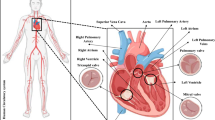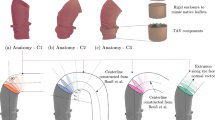Abstract
This paper investigates the effect of developing arterial blockage at the abdominal aorta on the blood pressure waves at an externally accessible location suitable for invasive measurements such as the brachial and the femoral arteries. Arterial blockages are created surgically within the abdominal aorta of healthy Wistar rats to create narrowing resemblance conditions. Blood pressure is measured using a catheter inserted into the right femoral artery. Measurements are taken at the baseline healthy condition as well as at four different severities (20, 50, 80 and 100 %) of arterial blockage. In vivo and in vitro measurements of the lumen diameter and wall thickness are taken using magnetic resonance imaging and microscopic techniques, respectively. These data are used to validate a 3D computational fluid dynamics model which is developed to generalize the outcomes of this work and to determine the arterial stress and strain under the blockage conditions. This work indicates that an arterial blockage in excess of 20 % of the lumen diameter significantly influences the pressure wave and reduces the systolic blood pressure at the right femoral artery. High wall shear stresses and low circumferential strains are also generated at the blockage site.













Similar content being viewed by others
References
Abassi Z, Goltsman I, Karram T, Winaver J, Hoffman A (2011) Aortocaval fistula in rat: a unique model of volume-overload congestive heart failure and cardiac hypertropy. J Biomed Biotechnol 2011:1–13. doi:10.1155/2011/729497
Bathe M (1999) Kamm RD (1999) A fluid-structure interaction finite element analysis of pulsatile blood flow through a compliant stenotic artery. J Biomech Eng 121:361–369
Cebral JR, Castro MA, Putman CM (2005) Numerical simulation of flow alterations after carotid artery stenting from multi-modality image data. In: Third MIT conference on computational fluid and solid mechanics, pp 607–611
Chan WC, Wright C, Riddell T, Wells S, Kerr AJ, Gala G, Jackson R (2008) Ethnic and socioeconomic disparities in the prevalence of cardiovascular disease in New Zealand. N Z Med J 121(1285):11–20
Charvatova Z, Ostadalova I, Zicha J, Kunes J, Maxova H, Ostadal B (2012) Cardiac tolerance to ischemia in neonatal spontaneously hypertensive rats. Physiol Res 61(Suppl. 1):S145–S153
Daghero F, Bueno N, Peirone A, Ochoa J, Torres GF, Ganame J (2008) Coarctation of the abdominal aorta an uncommon cause of arterial hypertension and stroke. Circ Cardiovasc Imaging 1:e4–e6
Doggrell SA, Brown L (1998) Rat models of hypertension, cardiac hypertrophy and failure. Cardiovasc Res 39(1998):89–105
Ebrahim S, Montaner D, Lawlor DA (2004) Clustering of risk factors and social class in childhood and adulthood in British women’s heart and health study: cross sectional analysis. BMJ 328(7444):861. doi:10.1136/bmj.38034.702836.55
Gao F, Ohta O, Matsuzawa T (2008) Fluid structure interaction in layered aortic arch aneurysm model assessing the combined influence of arch aneurysm wall stiffness. Australas Phys Eng Sci Med 31:32–41
Gerbeau J-F, Vidrascu M, Frey P (2005) Fluid–structure interaction in blood flows on geometries based on medical imaging. Comput Struct 83(2005):155–165
Gianluca DS, Peter M, Mathieu DB, Patrick S, Pascal V, Bendict V (2010) Patient-specific computational fluid dynamics: structured mesh generation from coronary angiography. Med Biol Eng Compu 48(4):371–380
Hedenqvist P (2008) Anaesthesia and analgesia for surgery in rabbits and rats: a comparison of the effects of different compounds. Ph.D. thesis, Karolinska Institutet, Stockolm, Sweden
Langeveld B, Roks AJ, Tio RA, VanBoven AJ, Van der Want JJ, Henning RH, Van Beusekom HM, Van der Giessen WJ, Van Gilst WH (2004) Rat abdominal aorta stenting: a new and reliable small animal model for in-stent restenosis. J Vasc Res 41:377–386
Larsen NE, Leshchiner EA, Parent EG, Hendrikson-Aho J, Balazs EA (1991) Hylan gel composition for percutaneous embolization cardiovascular. J Biomed Mater Res 25(1991):699–710
Marshall S, Milligan A, Yates R (1994) Experimental techniques and anaesthesia in the rat and mouse. Anzccart Fact Sheet 7(1):1–4
Mendis S (2005) Cardiovascular risk assessment and management in developing countries. Vasc Health Risk Manag 1(1):15–18
Nichols WW, O’Rourke MF (2011) McDonald’s blood flow in arteries. Hodder Arnold, London
Rentschler ME, Baxter BT (2008) Screening aortic drug treatments through arterial compliance measurements. Curr Vasc Pharmacol 6:250–257. doi:10.2174/157016108785909751
Restini C, Reis R, Costa-Neto C, Garcia-Cairasco N, Cortes-de-Oliveira J, Bendhack L (2012) Role of endothelium on the abnormal Angiotensin-mediated vascular functions in epileptic rats. J Biophys Chem 3(2):174–182
Russell JC (2003) Of mice and men, rats and atherosclerosis. Cardiovasc Res 59(2003):810–811
Sebastia C, Quiroga S, Boye R, Perez-Lafuente M, Castella E, Alvarez-Castells A (2003) Aortic stenosis: spectrum of diseases depicted at multi-section CT. Radio Graph 23:S79–S91
Soudah E, Ng EY, Loong TH, Bordone M, Pua U, Narayanan S (2013) CFD modelling of abdominal aortic aneurysm on hemodynamic loads using a realistic geometry with CT. Comput Math Methods Med 2013:9, Article ID 472564
Still WJS, O’Neal RM (1962) Electron microscopic study of experimental atherosclerosis in the rat. Am J Pathol 40(1):21–35
Tang D, Yang C, Kobayashi S, Ku DN (2001) Steady flow and wall compression in stenotic arteries: a three-dimensional thick-wall model with fluid–wall interactions. J Biomech Eng 123:548–557
Vukicevic AM, Stepanovic NM, Jovicic GR, Apostolovic SR, Filipovic ND (2014) Computer methods for follow-up study of hemodynamic and disease progression in the stented coronary artery by fusing IVUS and X-ray angiography. Med Biol Eng Comput 52(6):539–556. doi:10.1007/s11517-014-1155-9
Wronska-Nofer T, Szendzikowski S, Oberebska-Parke M (1980) Influence of chronic carbon disulphide intoxication on the development of experimental atherosclerosis in rats. Br J Ind Med 37:387–393
Yannis P, Nicolas A, Ioannis S, Mohmmad IK, Georgios CB, Elena E, Andreas SA (2013) Effect of head posture on the healthy human carotid bifurcation hemodynamics. Med Biol Eng Compu 51(1–2):207–218
Acknowledgments
This study was supported and funded by IBTec (Institute of Biomedical Technologies), Auckland University of Technology. The animal data were collected at Vernon Jansen Unit (VJU) at the University of Auckland with ethical approval R915 and the assistance of Dr. Jun Lu and IBTec’s PhD Candidate Miguel Jo-Avila. There are no known conflicts of interest associated with this publication, and there has been no significant financial support for this work that could have influenced its outcome.
Author information
Authors and Affiliations
Corresponding author
Rights and permissions
About this article
Cite this article
Al-Rawi, M., Al-Jumaily, A.M. Assessing abdominal aorta narrowing using computational fluid dynamics. Med Biol Eng Comput 54, 843–853 (2016). https://doi.org/10.1007/s11517-015-1375-7
Received:
Accepted:
Published:
Issue Date:
DOI: https://doi.org/10.1007/s11517-015-1375-7




